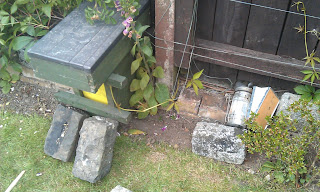Yesterday I got a call about a honey bee swarm over in Bilton. It was in a hedge in an elderly chaps garden, and would I like to collect them? Yes I would. would I charge for it? Nope, afterall assuming I didn't mess up I was going to come away with a little colony of bees. Saves them a job, saves the old chap some money, saves the bees lives, avoids a few millilitres of pesticides being used and gets me some bees. Everyone's a winner :) I got my stuff together, rang the chap, the bees had been there for 8 days so far.. Aided by Satnav I went to see the bees.
I've never actually collected a swarm before but I've read a lot about it and watched a lot of youtube videos on the subject so had a pretty good idea how to go about it. Basically you put a box above the cluster of bees and smoke them up into then put them in your hive, or you put the box or a sheet below and cut whatever branch they're on and pop them into your hive.
 |
| Looks simple enough |
Lying down and using my phone's built in torch (what will they think of next?) I had a look under the fence. I was slightly puzzled because there suddenly seemed to be a lot less bees. Looking at the small cluster I found they'ed been making comb. There was about three inches of pure white comb with stored nectar. I cut this out then resumed my examination of the shrinking bee colony. There was a few inches gap between the fence and the back of the neighbour's shed. They were in that gap. I realised that the bees I'd seen first, in the photo above, were only part of the cluster so the good news was more bees. Not being able to reach them was a little inconvenient though. Eventually I came up with a plan. I'd like to say a cunning plan but it was probably an obvious one really.
Putting the nucleus with five drawn frames vertically against the fence, propped up with stones from the garden wall and topped with the roof I aimed a few puffs of smoke behind the fence.
 |
| Blowing smoke behind the fence |
 |
| "We're in this box! Come on!" |
Removing the middle two frames I took the roof and turned it over, with the cluster above the gap left by the removed frames, and gently dealt it a sound wallop with the base of my fist then another. Glad I made the thing so strong now. That knocked all the bees but two into the nuc. I brushed out the pair of stragglers and carefully replaced the two frames. After a little smoke and application of the bee brush I put the crownboard and roof on and tied the whole thing up with a pretty blue bow.
 |
| In the box. |
I'd seen and heard some big noisy drones whilst hiving the colony but hadn't see the queen at all during the exercise and there were no eggs in the comb they'ed built. There's always a chance they didn't have one, and if they did there's the chance I somehow squished her or that the bees got annoyed during the operation and killed her themselves. However when I got my stethoscope to the hive today I heard a high pitched noise which I think was a virgin queen piping so I suspect I managed to get her and just have to wait and see if she manages to mate now. That means leaving them alone for a fortnight. I may give them a feeder depending on the weather but there was already some food in the frames I gave them and I was able to see foragers coming and going today. When I open the hive in a fortnight I'll have to check for disease and varroa mite levels. It was a little trial and error and could have gone more smoothly but I think it went quite well, didn't even damage a plant.










No comments:
Post a Comment